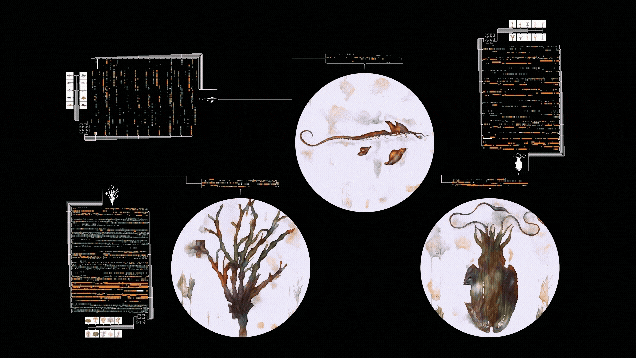The conference, taking place in one of Europe’s iconic art capitals, will feature a curated gallery that showcases how AI helps bring creative visions to life.
Imagery courtesy of Linda Dounia Rebeiz, Jeroen van der Most, aurèce vettier, Entangled Others Studio, fuse*, Noemi Finel.
“When an AI is trained on deeply personal data, it stops being just a tool,” said Mouginot, who since 2019 has worked as the artistic entity aurèce vettier. “It becomes a reflective device for poetic speculation.”
The French artist is one of seven exhibitors presenting artwork created with AI at NVIDIA GTC Paris, taking place June 10-12 at VivaTech.
The art gallery will showcase genre-challenging artists and fashion designers who are redefining what’s possible when human imagination meets machine learning — offering a window into the future of creative expression.
“This is an opportunity to reach audiences beyond traditional art spaces — white cubes, echo chambers — and to engage in a broader cultural conversation about AI,” said aurèce vettier.

Rendering of the AI art gallery at NVIDIA GTC Paris
Exploring ‘the Remembered and the Imagined’
For the series le travail des rêves and the light that is not seen, the artist trained generative AI models on images from his childhood and more recent photos from his phone. The generated images revealed dreamlike scenarios which he then transformed into oil paintings.

Oil paintings from the series “le travail des rêves” make a statement “that art made with machines can absolutely carry feeling, intimacy and myth.”
Imagery courtesy of aurèce vettier.

Painted in oil on canvas from an AI-generated image, “a bearded man crossing a forest surrounded by flocks of yellow butterflies” is from the series “the light that is not seen.”
Imagery courtesy of aurèce vettier.
AI as a Memory Machine
“I was concerned that people like me — usually at the periphery of how technology is built and disseminated — would be erased from its emerging narratives,” she said.
In 2021, Rebeiz embarked on a multiyear project, Once Upon a Garden, to document flowers her grandmother grew up with that no longer exist due to Earth’s rapidly diminishing biodiversity. She soon realized “the way we remember the world is uneven.”
Built in multiple iterations that reflect AI’s evolution over time, “Once Upon a Garden” is an explorable, speculative archive of critically endangered and extinct flora from the Sahel region of West Africa.
Imagery courtesy of Linda Dounia Rebeiz.
Intensive groundwork, preparation and tinkering paid off when her first AI model generated 10,000 images, a moment Rebeiz describes as an epiphany.

AI empowered Rebeiz to scale her art practice, incorporating generated images into collages, animations and physical paintings, including the above result of an artist-led collage workshop.
Imagery courtesy of Linda Dounia Rebeiz.
The fifth iteration or chapter of “Once Upon a Garden” also reflects Rebeiz’s explorations into video generation modules.
Imagery courtesy of Linda Dounia Rebeiz.
Entwining the Physical and Digital
Self-Contained delves into the intricate process of encoding and decoding visual information through AI and the expression of organic information in DNA form.

Harnessing NVIDIA GPUs, the NVIDIA StyleGAN2 model and public and personal datasets, “Self-Contained” transforms complex data into captivating visual narratives.
Imagery courtesy of Entangled Others Studio.

Imagery courtesy of Entangled Others Studio.
“Just as our cells divide, mutate and grow, so do the contents of our shared digital spaces as we remix, are remixed, hyped and made obsolete,” the studio founders said about the work.

An accompanying work, “self-contained 009.x,” stores a compressed version of the work in DNA form within a capsule fitted into a custom sculptural container.
Imagery courtesy of Entangled Others Studio.
Where Art Meets Science
Its work Onirica () attempts to give shape to dreams through visuals created by a text-to-image diffusion model trained on neurological datasets from the Laboratory of Psychophysiology of Sleep at the University of Bologna.
Drawing upon a dataset of more than 28,000 dreams, “Onirica ()” is a multimedia work created with the help of a text-to-image diffusion model.
Imagery courtesy of fuse*.
Creativity at the Root of AI
“The creation of such campaigns would have been impossible in the past due to budget and manpower requirements,” he said. “Thanks to AI, we now have potato commercials with Prada quality.”

Imagery courtesy of Jeroen van der Most.
“AI showed me all sorts of clichés that are present in our advertising language: the poses, the gestures, the looks of people,” he said. “It’s an incredible mirror of who we are and what we desire.”

Imagery courtesy of Jeroen van der Most.
Weaving AI Into the Fabric of Fashion Design
Both exhibitors will showcase the work of students, offering a window into AI’s role in the future of fashion and fashion campaigns as a tool for conceptual exploration.

Imagery courtesy of Noemi Finel.
For Matthew Drinkwater, head of the Fashion Innovation Agency at the London College of Fashion, exhibiting at GTC Paris is an opportunity to radically rethink how fashion operates from ideation to imagery.

Imagery courtesy of the Fashion Innovation Agency at the London College of Fashion.
Find the AI Art Gallery at GTC Paris at the Paris Expo Porte de Versailles, on the lower level of Hall 7.1, between the networking and VIP lounges.
Register for GTC Paris and visit NVIDIA’s virtual AI Art Gallery anytime.